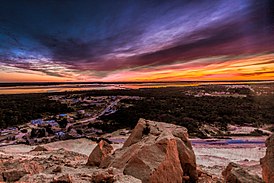Siwah Oasis
|
Siwa Oasis Isiwan / واحة سيوة / Siwa |
|
|---|---|
| City | |
|
Clockwise from top:
Shali Mountain village, oasis near Siwa, Ruins of the Old Siwa, Pigeon Towers, Lake Aftnas. |
|
| Coordinates: 29°11′N 25°33′E / 29.183°N 25.550°ECoordinates: 29°11′N 25°33′E / 29.183°N 25.550°E | |
| Country |
|
| Governorate | Matrouh |
| Population | |
| • Total | 32,741 |
| Time zone | EST (UTC+2) |
The Siwa Oasis (Arabic: واحة سيوة, Wāḥat Sīwah, IPA: [ˈwæːħet ˈsiːwæ]; Berber languages: Isiwan, ⵉⵙⵉⵡⴰⵏ) is an urban oasis in Egypt between the Qattara Depression and the Great Sand Sea in the Western Desert, nearly 50 km (30 mi) east of the Libyan border, and 560 km (348 mi) from Cairo. About 80 km (50 mi) in length and 20 km (12 mi) wide, Siwa Oasis is one of Egypt's most isolated settlements, with about 33,000 people, mostly Berbers, who developed a unique culture and a distinct language of the Berber family called Siwi.
Its fame lies primarily in its ancient role as the home to an oracle of Ammon, the ruins of which are a popular tourist attraction which gave the oasis its ancient name Oasis of Amun Ra. Historically, it is part of Ancient Libya.
The Siwa oasis is in a deep depression that reaches below sea level, to about −19 metres (−62 ft). To the west the Jaghbub oasis lies in a similar depression and to the east the large Qattara Depression also lies below sea level.
The Ancient Egyptian name of the oasis was Sekht-am, which meant "palm land". Early Arab geographers termed it Santariyyah.
Its modern name Siwa, first appeared in the 15th century; the etymology of the word is unclear. Basset links it to a Berber tribal name swh attested further west in the early Islamic period, while Ilahiane, following Chafik, links it to the Tašlḥiyt Berber word asiwan, a type of bird of prey, and hence to Amun-Ra, one of whose symbols was the falcon.
...
Wikipedia






